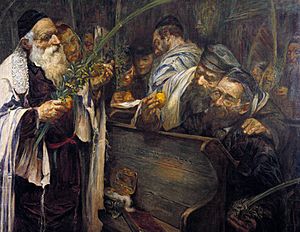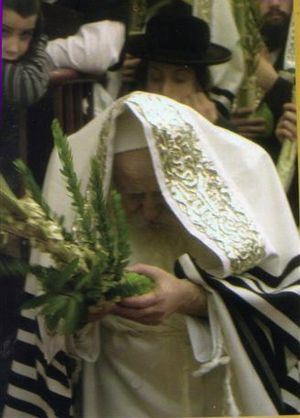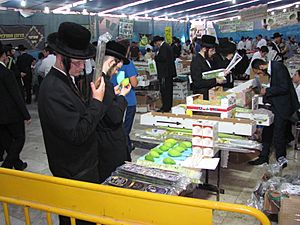Four species facts for kids

|
|
| Halakhic texts relating to this article | |
|---|---|
| Torah: | Leviticus 23:40 |
| Babylonian Talmud: | Sukkah Chapter 3 |
| Mishneh Torah: | Laws of Shofar, Sukkah, and Lulav 7:1–8:11 |
| Shulchan Aruch: | Orach Chaim 645–658 |
The four species (Hebrew: ארבעת המינים arba'at ha-minim) are four special plants. They are important for the Jewish holiday of Sukkot. This holiday is also called the "Festival of Booths."
During Sukkot, Jewish people gather these four plants. They tie three types of branches and one type of fruit together. Then, they wave them in a special ceremony. This happens every day of Sukkot, except on Shabbat (the Sabbath). This waving is a mitzvah, which means a good deed or commandment from the Torah. It has special meanings about serving God.
Contents
What Are the Four Plants?
The idea of using the four species comes from the Torah. In the book of Leviticus, it says:
Leviticus 23:40 And you shall take on the first day the fruit of splendid trees, branches of palm trees and boughs of leafy trees and willows of the brook, and you shall rejoice before the LORD your God for seven days. English Standard Version
The original Hebrew words for these four plants are:
- ‘êṣ hāḏār (עֵץ הָדָר), meaning "fruit of splendid trees"
- təmārîm (תְּמָרִים), meaning "palm trees"
- ‘êṣ ‘āḇōṯ (עֵץ עָבֹת), meaning "boughs of leafy trees"
- ‘arḇê-nāḥal (עַרְבֵי נַחַל), meaning "willows of the brook"
Over time, Jewish tradition identified these plants specifically as:
- Etrog (אתרוג): This is a special type of citrus fruit, like a lemon.
- Lulav (לולב): This is a closed, green branch from a date palm tree.
- Hadass (הדס): These are branches with leaves from the myrtle tree.
- Aravah (ערבה): These are branches with leaves from the willow tree.
| Part of a series on | |||
|---|---|---|---|
|
|||
| Judaism | |||
| Category | |||
| Jewish religious movements | |||
| Orthodox (Haredi • Hasidic • Modern) | |||
| Conservative • Reform | |||
| Reconstructionist • Renewal • Humanistic | |||
| Jewish philosophy | |||
| Principles of faith • Kabbalah • Messiah • Ethics | |||
| Chosenness • Names of God • Musar | |||
| Religious texts | |||
| Tanakh (Torah • Nevi'im • Ketuvim) | |||
| Ḥumash • Siddur • Piyutim • Zohar | |||
| Rabbinic literature (Talmud • Midrash • Tosefta) | |||
| Religious Law | |||
| Mishneh Torah • Tur | |||
| Shulchan Aruch • Mishnah Berurah | |||
| Kashrut • Tzniut • Tzedakah • Niddah • Noahide laws | |||
| Holy cities | |||
| Jerusalem • Safed • Hebron • Tiberias | |||
| Important figures | |||
| Abraham • Isaac • Jacob | |||
| Moses • Aaron • David • Solomon | |||
| Sarah • Rebecca • Rachel • Leah | |||
| Rabbinic sages | |||
| Jewish life cycle | |||
| Brit • Pidyon haben • Bar/Bat Mitzvah | |||
| Marriage • Bereavement | |||
| Religious roles | |||
| Rabbi • Rebbe • Posek • Hazzan/Cantor | |||
| Dayan • Rosh yeshiva • Mohel • Kohen/Priest | |||
| Religious buildings & institutions | |||
| Synagogue • Beth midrash • Mikveh | |||
| Sukkah • Chevra kadisha | |||
| Holy Temple / Tabernacle | |||
| Jewish education | |||
| Yeshiva • Kollel • Cheder | |||
| Religious articles | |||
| Sefer Torah • Tallit • Tefillin • Tzitzit • Kippah | |||
| Mezuzah • Hanukiah/Menorah • Shofar | |||
| 4 Species • Kittel • Gartel | |||
| Jewish prayers and services | |||
| Shema • Amidah • Aleinu • Kaddish • Minyan | |||
| Birkat Hamazon • Shehecheyanu • Hallel | |||
| Havdalah • Tachanun • Kol Nidre • Selichot | |||
| Judaism & other religions | |||
| Christianity • Islam • Judeo-Christian | |||
| Abrahamic faiths | |||
| Related topics | |||
| Antisemitism • The Holocaust • Israel • Zionism | |||
How to Prepare and Wave the Species
The special waving ceremony is called na'anu'im. In ancient times, this ceremony was done in the Temple in Jerusalem for all seven days of Sukkot. Outside the Temple, it was only done on the first day. After the Temple was destroyed, a wise leader named Rabbi Yohanan ben Zakkai said that the four species should be waved everywhere on every day of Sukkot (except Shabbat). This was done to remember the Temple.
Binding the Lulav Bundle
To get ready for the mitzvah, the lulav, hadass, and aravah are tied together. This bundle is often called "the lulav." Here is how it's usually done:
- One lulav branch goes in the middle.
- Two aravah branches are placed on the left side.
- Three hadass branches are placed on the right side.
This order is the same for everyone, whether they are right-handed or left-handed. The bundle can be tied with strips from another palm frond. Sometimes, a special holder made from palm fronds is used.
Some Jewish communities, like Sephardic Jews, have a slightly different way of binding. They place one aravah on the right of the lulav and one on the left. Then, they cover them with the three hadass branches. One hadass goes on the right, one on the left, and the third on top of the lulav spine, leaning a bit to the right. This bundle is held together with rings made from palm strips. Many Hasidic Ashkenazi Jews also follow this way.
It is important that all the plants are placed in the direction they naturally grow. For the etrog, this means the stem end should be at the bottom and the blossom end at the top.
Reciting the Blessing and Waving
When you say the blessing over the lulav and etrog, you hold the lulav in one hand and the etrog in the other. Most right-handed people hold the lulav in their right hand and the etrog in their left. For left-handed people, the custom can be different depending on their community.
Before saying the blessing, some people turn the etrog upside-down. This is done so that the mitzvah (the good deed) is only fully performed after the blessing is said.
The blessing is: "Blessed are You, Lord our God, King of the universe, Who has sanctified us with His commandments, and commanded us to take the lulav." The first time each year, another blessing called "Shehecheyanu" is also said.
After the blessing, the etrog is turned right-side up. Then, both hands are brought together so the etrog touches the lulav bundle. The four species are gently shaken three times in six directions:
- Forward
- Right
- Back
- Left
- Up
- Down
This waving shows that God is in charge of all parts of the world.
The waving ceremony can be done in a synagogue or at home, even in a sukkah (a temporary hut built for Sukkot). It must be done during the daytime. Girls and women can also choose to do this mitzvah, even though it is not required for them by Halakha (Jewish law).
The waving is also done during morning prayers in the synagogue. This happens several times while people say Hallel, which are special prayers of praise.
After Hallel in the synagogue, there is another ceremony. Worshippers walk around the synagogue with their four species. They say special prayers called hoshaanot, which mean "save us." From the first to the sixth day of Sukkot, they walk around once. On Hoshana Rabbah, the seventh and last day of Sukkot, they walk around seven times.
Choosing the Four Species
It is a special Jewish idea called hiddur mitzvah to do a mitzvah in the most beautiful way possible. This applies especially to the four species. Jewish law explains what makes each plant "the best." People often spend a lot of money to get the most perfect etrog, the straightest lulav, and the freshest hadass and aravah. Sometimes, a father will buy several sets for his sons to use.
An etrog can cost anywhere from $3 to $500, depending on how perfect it is. In the past, especially in Eastern Europe, it was hard to get these plants. Whole towns sometimes had to share them. Today, with better ways to travel and farm, more people can have their own sets.
There is also a rule called hadar (beauty) that is needed for the mitzvah to count. If the plants are not beautiful enough, the mitzvah cannot be performed. This is different from hiddur mitzvah, which is about making it extra beautiful.
Images for kids
See also
 In Spanish: Cuatro especies para niños
In Spanish: Cuatro especies para niños







